
The Dream Begins: From Sailboat Restoration to Family Cruising
Follow our family's adventures as we restore an old sailboat, learn to sail and expand our cruising horizons each day!
New Blog Address
You'll find new posts, pictures, videos and archives of all our old post from Sailblogs there on the new blog site. See you there!
Fall Storms on Lake Michigan
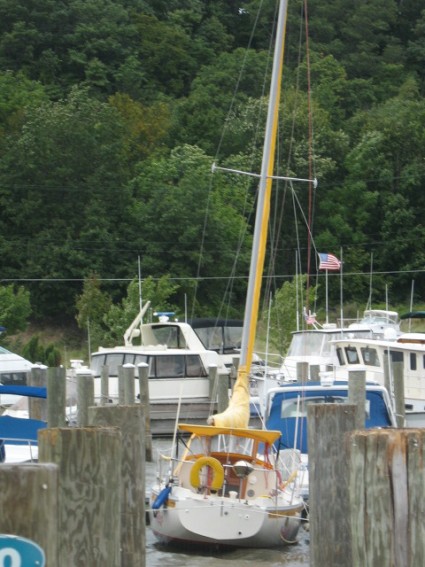
Check these videos for a better description than words can provide:
On the hard
Thursday (Oct. 8) was the day I dread every year...the day the boat is hoisted from the water and put on the hard for half the year. But that's the trade-off for boating in the beautfiul and abundant waters of the Great Lakes.
Island Bound was hoisted with North Shore's travel lift, powerwashed and set snuggly on her storage cradle for the long winter hibernation. I went back out on Saturday and winterized the engine (hopefully!), the freshwater system and the head. I also removed the sails and secured all lines and halyards for the winter. All she needs now is her cozy shrink-wrap blanket!


2009 Season Review
Now that fall has officially arrived here in the Great Lakes, I thought I'd make a quick post to review our first season aboard s/v Island Bound.
Incredibly to us, we actually spent significantly more nights aboard IB than we did on Hannabel. On average, we were living on the boat 5 out 7 nights per week. And once again, the dock life and community was amazing. We became close friends with several other boaters on our dock and look forward to continued friendship through the off-season.
After several daysails and another run at the 8+8 rally with IB to get to know her a bit, we first headed south back to Eldean Shipyard in Holland for two nights in late June. The trip back was a blast with 25+ kt winds, 6'+ waves and a small craft advisory! Island Bound handled the quartering seas wonderfully and cruised us back to Grand Haven on a fast (6+ kts) broad reach. My mom and dad picked up the girls in Holland and drove them home via automobile just to be safe.
In July we headed north for a week of cruising. On the trip north we stayed one night in White Lake, two nights in Pentwater, one night in Ludington, one night in Manistee and two nights in Portage Lake before turning back south. On the southbound trip we stayed another night in Pentwater and White Lake before tying back up in our home port of Grand Haven. Click here for a short video clip of a downwind wing & wing run from Pentwater to White Lake: http://www.youtube.com/watch?v=3zbFeIlxvLY
In August we headed back (did the same trip in 2008) to one of our favorite anchorages in Port Sheldon with two other boats (powerboats!) for two nights/days of fun and friendship on the hook. Perfect weather, great friends and good food combined for a very memorable weekend.
September was mostly spent close to Grand Haven enjoying several daysails and time at the dock. Now as October creeps onward, we'll be pulling Island Bound for the winter and daydreaming of another summer of sailing!





Island Bound!
Ok, so it's been waaayyyyyyy too long since I've made a blog entry. But hey, I've got a good excuse: We've been busy enjoying our new boat. That's right, we reluctantly sold our beloved Hannabel and moved up to a Caribbean themed Irwin 28 MkIV named "Island Bound".
Let me introduce you to our new girl. Here are her vitals...
LOA: 28'5"
LWL: 23'
Beam: 9'
Draft: 4'6"
Displacement: 7,800 lbs
Ballast: 3,000 lbs
She's got everything we want in our "next boat". The list includes straight shaft inboard, furling headsail, standing headroom, plumbed head, functional galley, plenty of storage and a bit more speed. So far we've cruised from Muskegon to Grand Haven, raced in the Grand River Sailing Club's 8+8 Rally, cruised to Holland and enjoyed numerous day sails and wonderful nights at the marina. Stay tuned for more frequent updates!






Winter's halftime
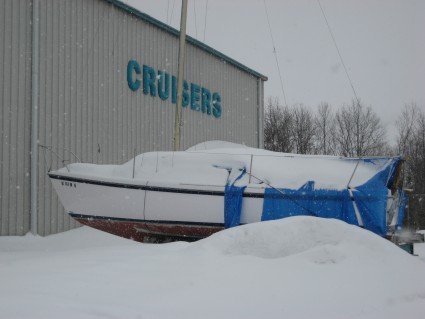
Great Lakes Sailing
Of course, I'll continue to keep this blog going with new posts and updates too! Thanks for reading and happy holidays!
Video Review
Hannabel Slideshow on YouTube
Enjoy!
Helms 25 Boat Review
There are many small sailboat builders who had passion, good designs and quality craftsmanship that are no longer in business. The sailboat market can be fickle. Demand ebbs and flows. Niches grow and shrink. Fortunately, many sailboats from years ago survive the market conditions, unlike some of their respective builders. Today we're left with a few choices in the pre-owned market for small, trailerable weekend cruisers. If you're shopping, don't overlook some of the smaller builders like Helms Yachts.
Helms Yachts were built in Irmo, South Carolina during the 1970s and early 1980s by Jack Helms. To the best of my knowledge, only 600-800 total boats were built throughout the Helms line. Jack supposedly personally delivered most of the boats. The company's first boat was the Helms 25. Eventually a 27 was added, followed by a 30, which was later replaced by a 32 footer. Several hundred of the 24, 25, 27 and 30 foot boats were built, but only 10 of the 32 footer were ever built.
Jack Helms is rumored to have said that he wanted to create a "better Catalina 22/25" when he began his company with the Helms 25. Jack is credited with both the construction and design of the Helms 25, while he relied on design services from Stuart Windley and John Holmes for the design of other boats in his product line. The boat looks very similar to a larger scale Catalina 22, except for an extended cockpit on the Helms. This extension allows the Helms to comfortably seat six in the cockpit while daysailing or two to four while cruising for extended periods. The cockpit also features large lazerettes and a teak coaming box on either side for storage.
The mould for the Helms 25 was adapted from a Venture 24 hull with a nearly full-length skeg added to the keel of the boat. The hull is solid fiberglass while the deck has a wood core. The Helms 25 also features a hinged retractable centerboard design, making it a great gunkholer and trailer-sailor. In fact, these boats were originally sold from the factory with a custom tandem axle bunk trailer. Many owners still maintain and use the original trailers.
Total displacement is 3950 pounds while ballast is 1650 pounds, including the 300 pound centerboard. The centerboard is controlled via a cable and winch located just under the step inside the companionway. Draft with the centerboard up is a scant 20 inches while draft with the board down is a full 6 feet. Length overall is 24 feet 10.5 inches, while length at the waterline is 21 feet 6 inches. The beam is narrow at just 7 feet 11.5 inches.
The Helms 25 was rigged from the factory as a masthead sloop. She has a transom hung rudder with tiller steering. The rudder will kick up in shallow water if a bolt or pin is removed, thus adding to the boat's shallow water resume. In fact, with the centerboard retracted and the rudder in "kick-up" mode, the Helms 25 can be safely beached. The original running rigging features end-boom sheeting with a transom traveler bar for the mainsheet. The headsail sheets are lead aft through outboard adjustable car tracks. The boats came with two rather smallish primary sheet winches and a third mast mounted halyard winch.
One unique feature of the Helms 25 rigging is a rolling boom, which is handy for mainsail storage and reefing (more on that later). The deck-stepped mast features a rather typical standing rigging arrangement: one set of spreaders, forestay, single backstay split at the transom, double lower shrouds, and single outer shrouds. The chainplates for the lower shrouds are attached to the deck and backed by rather small stainless steel plates. I recommend enlarging these backing plates for added strength. The outer shroud chainplates are attached through the deck to a teak bulkhead in the cabin. There is a single lifeline running from the stern pulpit to the bow pulpit on each side of the boat. On my boat, the middle stanchions are backed by appropriately sized stainless steel plates while the stanchion backings that are less readily seen are backed by marine grade plywood. The wood backing plates should be replaced with steel backing plates for added strength.
The cabin layout is typical of a small cruising boat. There is a large v-berth forward that has plenty of shoulder and legroom for two adults. Just aft of the v-berth is the porta-pottie to port. Later models (after 1975) feature a small open hanging locker to starboard. Earlier models such as mine simply have the v-berth extend aft a bit further. Moving aft is either a full or half height teak bulkhead on either side with a teak mast compression post on centerline. Next to port is a convertible dinette table that comfortably seats two adults but will accommodate two adults and two children with a bit of elbow and hip rubbing. With the table converted to a bed, there is ample sleeping room for two children or one adult less than 6 feet tall. To starboard across from the dinette is a compact "galley" featuring a poorly insulted icebox and a small stainless sink with a handpump faucet. Just aft of the galley on the starboard side is a cushioned bench that extends into a quarterberth under the cockpit. The quarterberth is suitable for sleeping one child or an adult who doesn't need much shoulder room. Aft of the dinette on the port side is a sail locker accessible by tipping the aft dinette seatback forward. There is ample storage throughout the cabin beneath all seats and berths. However, most of these storage areas are directly in the bilge so items should be kept in sealed plastic bins.
Ventilation for the cabin is provided via the companionway and two deck hatches, one over the head of the v-berth and another smaller hatch near the foot of the v-berth. There is plenty of natural light in the cabin from the two large and rather dated plexiglass portlight windows on each side. The companionway hatch also slides forward far enough to give plenty of additional light and ventilation. The biggest drawback of the cabin is the lack of standing headroom for anyone more than 5 feet tall. This issue was partially addressed in later models with the addition of a pop-top option.
Auxiliary power for the Helms 25 comes via an outboard motor mounted on an adjustable bracket on the port side of the transom. The subject boat for this review was powered with an 8 horsepower 2-stroke Nissan. Other owners I have talked with report having outboards between 8 and 15 hp. Eight horsepower is more than adequate for inland waters while boats operating in areas with tidal currents, wave surge and potentially large swells might be better off with a 15 horsepower outboard. The Helms 25 handles well under power in both forward and reverse, so docking and maneuvering are relatively easy tasks. This characteristic is aided by the retractable centerboard, allowing the captain to raise the board when under power and thus reduce drag and keel depth for responsive steering.
The particular Helms 25 that is the subject of this review carries a sail inventory which includes a 125 square foot mainsail, 225 square foot 150% genoa, 160 square foot laper/jib and a 400 square foot symmetrical spinnaker. In wind conditions up to about 15mph - 18mph, the main and genoa move the boat along nicely. She's an average light air boat and will achieve about 3 or 4 knots in wind less than 10mph. She feels just right in about 15mph winds and will move nicely at about 6 knots on a reach. The United States Performance Handicap Racing Fleet gives the Helms 25 an average rating of 240, which puts it right between the two target boats from Catalina.
At wind speeds above 18mph, reefing and/or reducing headsail size should be considered. Reefing the main on a Helms 25 can be done by simply rolling the roller boom to furl in the sail until the reefing hook on the boom can be attached to a reef point on the sail. The leach of the mainsail also requires a reefing line. The mainsail can also be stored by rolling the boom to completely furl the main. The test boat did not have a roller furling headsail, so a crew member must go forward on deck to change the hank-on headsails. The side decks on the Helms 25 are rather narrow and are almost impassable near the chainplates. Experience says that it is safer to go forward by crawling over the coachroof than by using the sidedecks.
The Helms 25 will handle moderate seas with comfort and confidence. She cuts through most waves and swells with ease and rarely slams. However, weatherhelm is fairly quick to develop so the helmsman and crew must learn the nuances of sail trim and traveler positioning to minimize this effect. She is not the greatest boat for pointing high into the wind, though she'll run downwind very well with the centerboard retracted to reduce drag. Care should be taken with a stern or quartering sea because the large cockpit does not have adequate drainage to quickly bail water. Early models have just two small scuppers in the front of the cockpit that drain via a single hose out of a single thru-hull on the transom. Later models have the scuppers moved to the rear of the cockpit and have additional drains on the forward corners of the cockpit benches to help drain rain water. Rainwater collects in the corners of the cockpit benches on earlier models. Adding drains is a fairly simple task and helps ensure a dry cockpit.
The Helms 25 has very few areas that can allow seawater to enter the boat. One area is the transom thru-hull that serves as the drain for the cockpit. The other areas are the pipe through which the centerboard cable travels and the centerboard pivot bolt. However, both of these are typically above the waterline and present minimal risk for water intrusion though they should be inspected on a regular basis. The paucity of thru-hulls on the Helms 25 leads to the conclusion that rain rather than seawater is the enemy (see note on cabin windows below).
As with any boat, particularly a boat that is 30 years old, a careful inspection and/or professional survey should be done prior to purchase. Be sure to inspect the centerboard pivot bolt and seal as the bolts can corrode over time and the seal can suffer from dry rot. Replacement is difficult and requires the boat to be hoisted so the 300-pound centerboard can be removed. Also check the centerboard winch and cable for signs of wear and meat-hooking. As is typical of all cored decks, you will want to inspect for soft spots and water intrusion around deck hardware, particularly around the lifeline stanchions and chainplates. The cabin windows on Helms 25s are also known to leak and require complete removal and resealing to fix the problem. While this is not a terribly difficult job and should not be a deal killer, it should be noted during the inspection. While Helms 25s are becoming more and more rare in the pre-owned sailboat market, good examples can still be had anywhere from $1000 to $7000. Many will require some work, but what boat from the 1970's doesn't? In fact, what boat, no matter the vintage, doesn't require some work?
For a boat built in the 1970's by a small company that is no longer in business, the Helms 25 has held up tremendously well, both stylistically and structurally over the years. Credit Jack Helms and his cabinet making background and attention to detail for much of this. The Helms 25 offers good value in a large but manageable trailer-sailor that can serve as a great gunkholer and weekend getaway while still offering plenty of good sailing characteristics to please even the avid Wednesday night racer. She is also blessed with a lot of storage and roomy berths for the weekend cruiser. There are not a lot of choices in the 25 foot trailer-sailor category that feature a shallow draft, decent sailing ability and moderate cruising comforts for a very modest budget. Fortunately, the first boat ever offered by Jack Helms fills the void.
Oh what a summer!
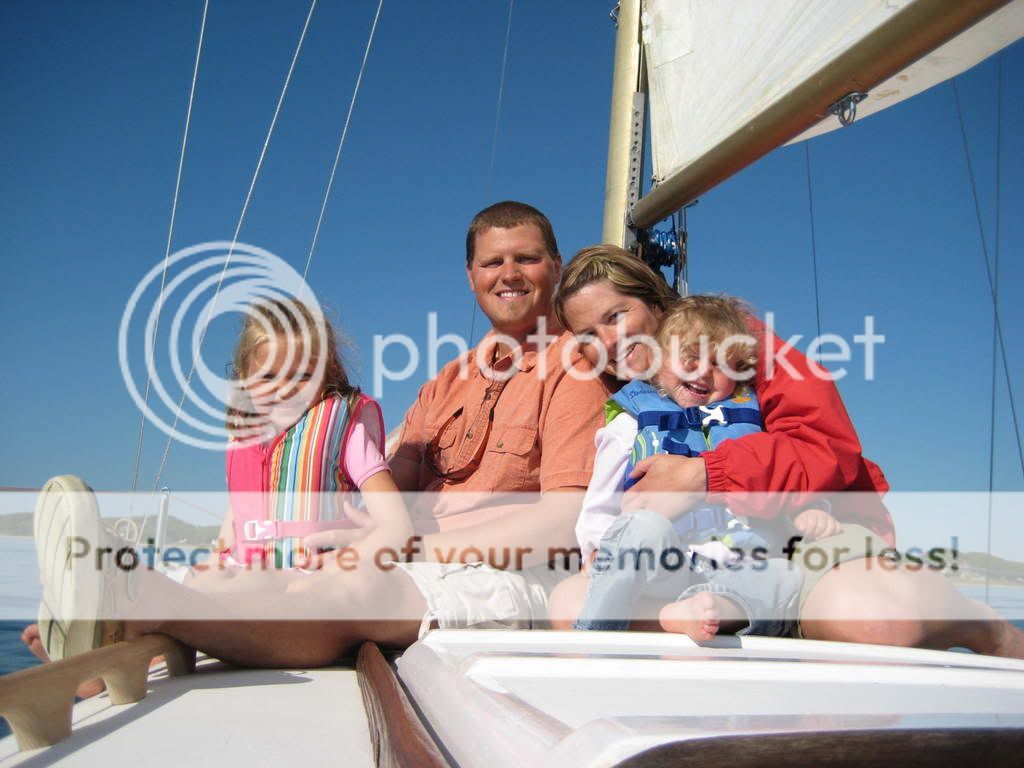
�
I should have listened to my dad when he warned that purchasing a boat would only make the summer go by more quickly and the winter more slowly.� I now sit at the edge of a very long winter reflecting back over a very fast, yet enormously memorable summer. Maybe somehow putting it all down on paper will make the sailing from this past summer last just a bit longer.
�
Let's start at the beginning.� Before this summer, I was first a young boy spoken to by the sweeping sheerline of a Maine lobster boat, an adolescent teen enjoying the wind in my hair from the bow of mom and dad's boat, and more recently a novice sailor seeking wisdom from the wind and waves aboard a Laser on Lake Charlevoix.� In fact, just one summer ago I was a mere armchair sailor, reading all I could about sailing adventures in far off places.� The internet was my virtual showroom allowing me to step aboard the thousands of sailboats listed for sale and drift just a little further into my South Pacific fantasy.
�
But now, as you read on, you will see that I've traveled far in just one summer, even if mostly only figuratively.� Am I any closer to my dream of sailing around the world?� Not really, mathematically speaking.� Absolutely, however, in reality!� I am blessed with the knowledge that the longest voyage starts by simply casting off the first dockline.� So read on and see just what all was involved in casting off.
�
On the day our little Hannabel was launched back in early May, I pondered in my blog: "...did I miss some hidden spot on the hull where water could get inside?� Will the swingbolt for the centerboard be watertight?� Time will tell."� Indeed, time has told.� Hannabel is seawatertight.� However, she does let the occasional drip into the cabin during heavy rains.� Rain seems to be the enemy of Hannabel, not the sea.
�
Then came our first sail on Hannabel.� I gulped it all in: the way it felt to rig the boat for real sailing, the smell of 2-stroke outboard exhaust, the adrenalin rush that accompanied scurrying forward on the deck to set the sails for the very first time, the sweep of the boom on that very first tack.� Sailing on this day was everything I had hoped it would be.� Well ok, I didn't hope for the outboard engines problems (snapped pull cord, stuck choke, broken shifter) but engines aren't part of real sailing anyway, are they?
�
As we gained experience and confidence, we began to let more and more water pass under our keel.� On a sunny day in early June we had a full crew (mom, dad, Hannah, Isabel, Erin and I) aboard as we pointed the bow north to Muskegon.� The air was light but our ambition was heavy and hunger for lunch at Dockers kept us moving!� We logged 25 nautical miles that day in the sun and calm seas.
�
When we paid our slip fees last winter, we made an oath to spend more days and nights aboard Hannabel than at home.� Sure, we massively lowered our "cost per night" of slip rental, but more importantly we got to live a docklife.� In any typical seven-day summer week, we spent at least four nights aboard Hannabel.� That equates to about 50 nights spent aboard Hannabel this summer.� So much time spent at the marina engenders you with many new friends and neighbors.� There were parties galore celebrating birthdays, anniversaries, launchings and just about any other event including the setting (and sometimes rising) of the sun!� We twice watched the air fill with "sulpheric sensation"; once on the fourth of July and a second time during the Coast Guard festival.� Camaraderie is a big part of boating for our family.
�
Then there are all the great meals we enjoyed while onboard or on the dock.� One of my favorites was Erin's crockpot rendition of "meigas", a Mexican-style quiche served on top of corn tortillas...very delicious!� Or how about a seafood bake and boil right on the dock with crab, shrimp and fresh-caught yellow perch?� We had that too!� Of course we also had plenty of tube steaks (hot dogs) and beans when we needed to keep things simple and quick.� But hey, there's probably not a better food on earth for the money.� In fact, one of the most memorable meals was an afternoon of grilling brats on the beach in Holland just as the summer's most formidable storm was rolling in.� The coast guard wisely recommended that we "wrap up the barbeque and take shelter".� We heeded their advice and took the brats with us on the dinghy back to Hannabel and waited out the big storm in the "safety" of the cabin while we dinned.
�
We also were able to experience a fair amount of racing in our first season on the water with Hannabel.� Erin and I will not soon forget the 8+8 Rally.� This was our first chance to sail far from the land, as we raced 8 miles out into the lake and 8 miles back.� There was a stormy start, a becalmed middle and a perfect end.� Then there was the 70th running of the South Shore Yacht Club's Queen's Cup.� I was fortunate enough to get a spot as a foredeck crewmember on a 38 footer.� I'll never forget the fear of starting the race in a fierce thunderstorm with low visibility, or the feeling of a massively heeled boat racing along with hundreds of other boats at an average of 8 knots, or crossing all 84 nautical miles of Lake Michigan in the dark of night, or the sight of dozens of flashlights lighting up sails to check telltales, or the sleeplessness of "sleeping" on a heeled side deck, or the view of the sun rising over Grand Haven from 30 miles offshore.� I also enjoyed many Wednesday evening races aboard the same yacht and can tell you that there's more to be learned sailing one race than there is in an entire season of cruising and daysailing.�
�
Between cruises to Muskegon, Holland, Port Sheldon, Hoffmaster State Park and as many day sails as we could manage, Hannabel tallied some 225+ miles of sailing this season.� Sure, that's just a couple days worth of water beneath the keel on passage from the Galapagos to the Marquesas, but we're plenty proud of season one's logbook.� Stay tuned for off-season reports, random sailing thoughts and plans for season two!A night on the hook!
On what turned out to be a rather spontaneous decision, we threw off the docklines and headed south towards Port Sheldon and Pigeon Lake.� The crew consisted of Erin, Hannah, Isabel, Shasta and I.� The weather forecast was perfect...10-15 knot winds out of the north with waves 1 foot or less.
�
We rounded the south pier head of Grand Haven at about 11:30am and enjoyed a perfect broad reach for 8 nautical miles to Port Sheldon.� The wind and waves were so very right that day that we did not even once take a tack or pull on the jib sheet.� Just awesome sailing!
�
Port Sheldon is listed in the chart books as simply a "port of refuge" with no services or marinas.� Fair enough, we were looking for a bit of relaxation and quiet before the busy holiday weekend that lay ahead.� The channel into Pigeon Lake is a bit narrow and sometimes shallow, but well worth navigating because of the clear blue water and narrow sandy beaches on the shorelines.� We motored down the channel and into Pigeon Lake proper.� Just inside the lake to the north side is a nice little cove that is perfect for anchoring.� We dropped the hook in about 12 feet of water and promptly took Little Coconut ashore for some exploration and a shore lunch.�
�
Little Coconut is a small but very row-able dinghy.� She just barely holds the four of us, so Shasta (our golden retriever) was "forced" to swim in along side of us.� This may sound a bit cruel, but if you know Shasta you know that we suspect her of having gills and webbed feet.�
�
The northern shoreline of Pigeon Lake has a very nice boardwalk along a narrow sandy beach that stretches for about 1/2 mile.� We ate our picnic lunch one of the many benches along the boardwalk and scoped out the best place to spend the afternoon laying around on the beach.
�
By the time we made it back to Hannabel, the anchorage was starting to fill in.� In fact, by nightfall there were about 12 boats total.� Some new friends of ours from our marina even showed up in their Pearson 30 named Whispurr.� I spent a few minutes in the�diminishing dusk light with my mask and snorkel on scrubbing the bottom of Hannabel.��The water in Pigeon Lake was so clear and inviting that I couldn't resist the evening swim.�
�
After our�dinner of grilled catfish, garlic�bread and salad, we enjoyed�a Dark & Stormy (rum & ginger ale) in the cockpit as the girls played in the cabin.� As the sun set on a perfect day, Marc, Marilyn and their two�kids (from Whispurr) joined us in the cockpit for an hour or so of laughter and fun.�
�
We woke the next morning to a very�serene lake with a�heavy fog concealing anything more than 50 feet away.� After we�all had breakfast, we took a morning bath/swim in the lake.� There's nothing more refreshing than an early morning swim in a clear, calm lake! It's wasn't long after 9:30am that we had Hannabel headed back towards Grand Haven. As luck or King Neptune would have it, we had a light 8 knot breeze out of the south/southwest and were able to again enjoy a tackless broad reach all the way home. In fact, the sailing was so smooth and peaceful that the girls enjoyed at least half of the trip in the dinghy as it was towed behind Hannabel. Good friends, good sailing and a peaceful anchorage make for a very memorable late summer voyage!

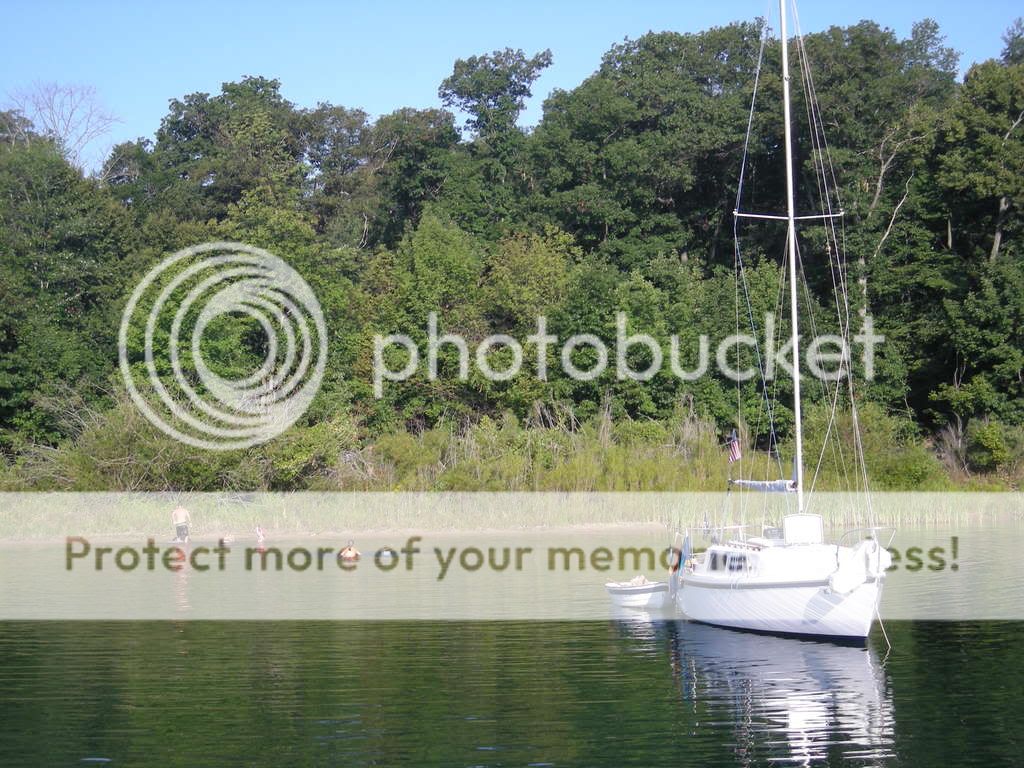
It's good to be away!
 �
� On Wednesday, July 16, 2008, we embarked on our first overnight cruise from our homeport.� We had originally planned to sail from Grand Haven to Saugatuck (~24 nautical miles) to meet up with some friends who have a boat there.� The voyage from Grand Haven to Saugatuck affords a couple of ports in between for weathering a storm, provisioning, etc.� The ports are evenly spaced with Port Sheldon/Pigeon Lake being a short hop at 9.5nm and Holland being an additional 8nm.�
�
The forecast for Wednesday, our departure day, called for winds out of the south from 5-15 knots.� This meant a tough, slow beat upwind.� Luckily the seas were only 1-2 foot and the sky was clear.� We stayed on Hannabel the night prior to the trip and both Erin and I woke early Wednesday morning (6:00am) with excitement, ready to begin our journey.� We rounded the Grand Haven pier and headed south at about 9:00am.� The girls both played for the first few hours.� Our dog, a golden retriever named Shasta, slept.� Then after a few snacks and a light lunch, both girls took a nice nap while Erin and I kept Hannabel on tight SE/SW tacks as we made our way south.� At about 2:00pm somewhere just south of Port Sheldon we decided that we would call it a day and make port at Holland.� We ended up pulling in to Holland and Lake Macatawa at about 4:00pm.� The 17nm trip from Grand Haven had taken us 8 hours and plenty of tacks.� We set two bow anchors and then took the dinghy to shore to cook dinner.
�
We were grilling our dinner on a beach about � mile from our anchorage when a Coast Guard RIB pulled up and announced on their loud speaker that we should "wrap up the barbeque...there's a storm headed our way with wind gusts to 50 knots and possible hail."� Needless to say, we hastily broke camp and hurried back to Hannabel to prepare for the blow.�
�
The sky darkened and a very ominous roll cloud appeared just as we approached Hannabel from the dinghy.� Erin, the girls and the dog all prepared to hunker down in the cabin as I scurried about on deck in gusty winds and a light drizzle tying down the sails and worrying about the anchors holding.� As several strong wind gusts blew across our bow, I quickly decided that I'd feel safer picking up one of the many vacant nearby mooring balls rather than trusting our undersized anchors.� All ended up well as Erin masterfully maneuvered Hannabel under power while I secured a bowline to a mooring ball just as the storm hit with full force.� We hustled down into the cabin and finished our dinner with all hatches and hatch boards secured for a damp, rolly start to our evening.� The storm moved on after about an hour and we enjoyed a pleasant evening on the mooring.�
�
The next morning, decided to abandon our plans for Saugatuck and grab a slip at Eldean Shipyard to enjoy the pool, hot tubs, restaurant and many other beautiful cruising sailboats at the marina.� Hannah and Izzy were thankful for a warm pool while Erin and I truly savored walking the docks and looking at all of the sticks in the harbor.
�
After two nights in Holland, we decided to head back to Grand Haven because of many severe thunderstorms in the forecast for the next several days.� We left Holland at about 8:00am on Friday morning with strong winds (20 knots) out of the south and 4-6 foot seas.� As we motored out of the breakwater we all felt a little nervous and uneasy with the motion of the boat under power.� Truly one of the greatest attributes of sailing vessels is their balance and relative comfort (compared to powerboats) while under sail.� We raised the main with a single reef and shut of the engine.� Hannabel quickly settled in to a nice comfortable rhythm and we gradually gained our confidence.� With the seas and wind at our stern, we were able to let the main out and enjoy a nice surf to the north.� After about 30 minutes, we decided to raise the 100% jib.� After the jib was up, we sailed wing-and-wing northward at about 5 to 6 knots.� Another hour passed and we felt like the wind had decreased a bit (perhaps 15-20 knots true?).� At that point I went forward on the deck and took down the jib and hanked on the 120% genoa.� With a decrease in wind speed and a slight direction change we were able to cruise at an average of 6.5 knots on a broad reach all the way to Grand Haven.� The steel drum music and sing/dancing of Isabel and Hannah made for a very enjoyable cruise home.� The return trip took us about 4 hours, half the time of our initial trip.����
�

�

�

8+8 Rally
The Grand River Sailing Club graciously invited Erin and I to participate in their annual "8+8 Sailing Rally" and we happily accepted.�
�
The 8+8 Rally is a laid back "race" that uses a handicapped start so all boats finish relatively close together.� The course is set so the race has one turning mark 8 miles out on a beam reach.� I know many of the regular GRSC members don't really consider the 8+8 to be a race, but believe me, Erin and I were racing!� This was our first organized sailing event together with Hannabel and we're happy to report she did great!
�
The race started with dark storm clouds looming overhead and 15 mph winds bustling about.� But the conditions quickly mellowed out and all participants were sitting still in the water with little to no�wind for about an hour.� At that point the race committee decided to shorten the 8+8 to a 6+6 (6 miles out, 6 miles back) race.� Because of our PHRF handicap starting place, we were the first boat to round the turning mark and head back for the finish line.� The wind increased to 15 mph all the way back and we cruised along at a steady 6-7 knots.� We ended up finishing in 6th place out a total of 12 boats.� Not bad for a couple of newbie sailors!
�
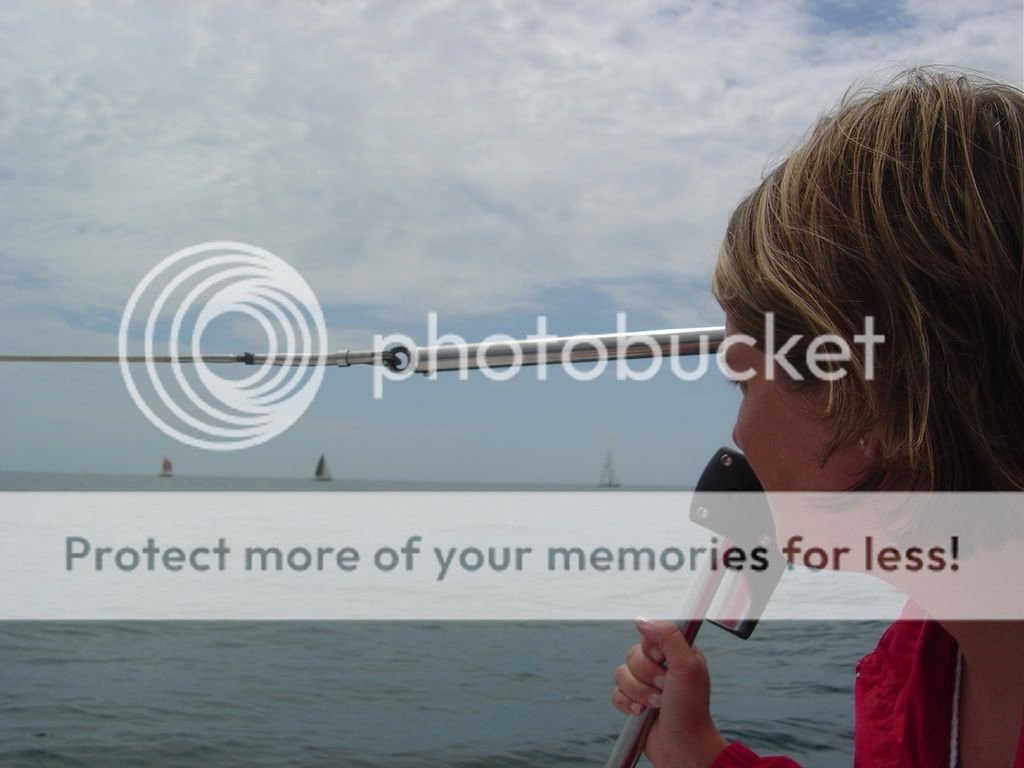
�
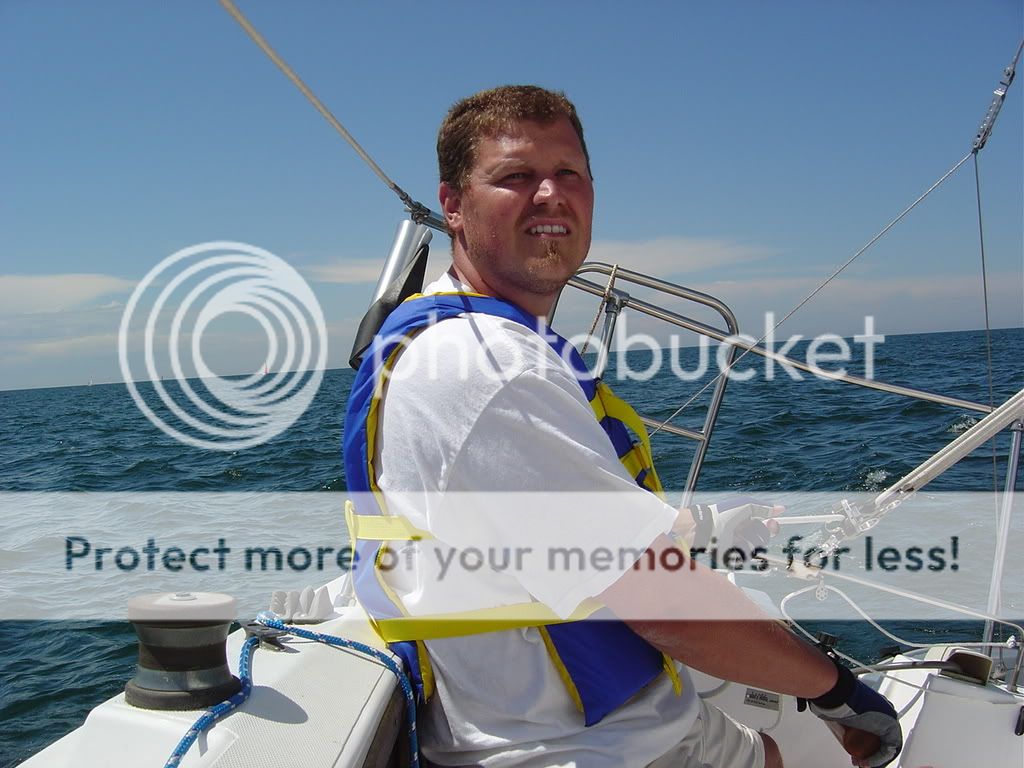
Queen's Cup
It's been a while since I've updated the blog, so I thought I'd take the time to make a few posts.
�
I was blessed with the good fortune of being asked to crew on 37 foot sailboat for the 2008 Queen's Cup race.� For those unfamiliar, the Queens Cup (http://www.ssyc.org/queenscup/default.asp) is one of the oldest cups in world-yachting still being offered for competition every year.� The race begins on the western shore of Lake Michigan in Milwaukee and finishes on the eastern shore in Grand Haven.�
�
Our boat and crew crossed on Wednesday morning from Grand Haven to Milwaukee (approximately 72 nautical miles) in near perfect sailing conditions.� We had 15-25 mph winds on our beam nearly the entire way and averaged about 6.8 knots for an 11 hour crossing.�
�
The race back home was even better.� We started in a thunderstorm and tacked around the starting area with a double reefed main.� Eventually the storm passed and we shook out the reefs and enjoyed an all night sail with the same winds (15-25 mph) but an even faster average speed of about 7.5 knots for a 9 hour and 47 minute crossing.� The boats, stars, lake conditions, skipper and crew were all very enjoyable.�
�
I learned a lot about sailing and Lake Michigan and am grateful to the skipper and crew of Windfeather for allowing me to take part.
�

�

�

Dockers for Lunch!
This past Sunday marked the first trip on Hannabel that was more than a mere daysail. Erin, Hannah, Isabel, my mom, dad and I all shoved off from the docks at North Shore Marina at about 11:00am and headed north to Muskegon for lunch.
The weather called for light air (5-10kts) out of the north, so we knew might be in for a long, slow trip of only 24 total miles. Still, we were eager to get some mileage beneath our keel so we worked our way windward...for about 3 hours. The trip to Muskegon was uneventful, as we munched on my mom's almond bars and basked in the sunny (but cool!) 1st day of June. Just west of Grand Haven we observed a couple of the USCG boats practicing towing drills as we sailed by at a very leisurely pace.
We pulled into the Muskegon breakwater and channel around 2:30pm and motored our way to Dockers. The food was good, even if they did take the very memorable calamari off the menu. There was also a live blues band and plenty of activities for the girls.
The trip back to Grand Haven was equally mellow. The winds remained at around 5kts, but shifted to a more NW heading. We sailed with the main and genoa about half way and then started the motor to give us a little extra push. The air temperatures were a bit warmer on the return trip so we all soaked up sun in the cockpit and on deck. Hannabel returned safely to her slip around 7pm.
We can't wait for our next trip!


| Vessel Name: | Island Bound |
| Vessel Make/Model: | Irwin 28 MkIV |
| Hailing Port: | North Shore Marina, Grand Haven, MI |
| Crew: | Kevin (Captain), Erin (Admiral), Hannah (First Mate), Isabel (Deck Hand) |
| About: | Kevin: Age 34 Erin: Age 33 Hannah: Age 7 Isabel: Age 4 |
| Extra: | Follow our family's adventures as we restore an old sailboat, learn to sail and expand our cruising horizons each day! Someday in the not too distant future we intend to cast off the docklines for a VERY long time. Then we'll go where the wind blows... |
The Dream Begins: From Sailboat Restoration to Family Cruising
